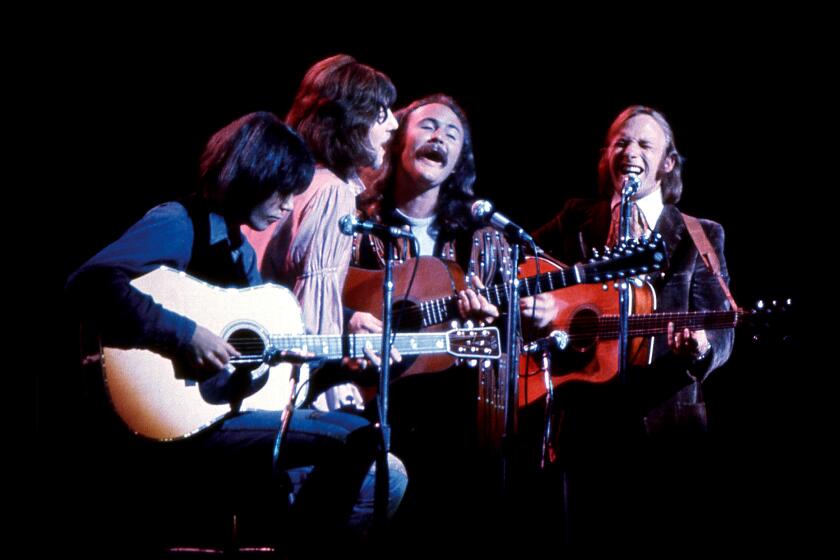O.C. THEATER REVIEW : A ‘Streetcar’ That Aspires and Achieves : A jewel-box set and haunting lighting evoke New Orleans as Williams envisioned it, with passionate characters as the actors envision them.
- Share via
FULLERTON — Authentic New Orleans jazz wafts seductively through Cal State Fullerton’s Arena Theatre as the houselights dim for the opening scene of “A Streetcar Named Desire.” It is a touch indicative of the care and affection, and the respect, that director Gretchen Kanne feels for Tennessee Williams’ text, for both the core of its intent and the aura of its theatricality.
In Nola Jackson’s richly detailed scenic design, the quaintly, languidly drab Kowalski flat in New Orleans’ Elysian Fields looks as authentic as the music sounds. The two rooms and the rickety stairs to the Hubble apartment echo the years of their existence and the dulling effect of the salt air and humidity. E. Junior Usaraga’s soft lighting heightens the effect, with umber shadows and golden highlights moving imperceptibly about the stage as the action progresses from room to room, from flat to lamp-lit street.
The visual design is like a jewel box for this gem of a revival of Williams’ drama about the decadent hope of a fading South, trying haltingly to make its entrance into the modern world.
For the most part, Kanne follows the text without varying its detail. The tones and shadings of the action are intact. Where her staging finds its own personality and its little surprises are in her casting of the central figures, rough-cut Stanley, his adoring and realistic wife Stella, and Stella’s tragic sister Blanche DuBois.
Barbara Streifel’s Stella has her feet planted firmly in the simple life she has chosen, and her strong sensuality in Stanley’s presence throbs with the animal attraction that has brought them together. It’s a perceptive performance informed by a touching honesty.
As Stanley, John Gonzalez takes some chances and makes them work. Forgetting the graven image of Brando’s Stanley completely, and wisely, Gonzalez gives the character charm, intelligence, a sometimes flashing sense of humor and an inner power that comes not from machismo but from a sure grip on the verities of life in his time and at this place.
The slowly simmering sense of justice beneath Gonzalez’s surface almost makes one want to applaud his treatment of Leslie Mitts’ Blanche. Her performance takes even more chances than Gonzalez’s does. This is not a wispy, ethereal Blanche living in a dream world. She is a full-blown vixen; her fantasies aren’t so much dreams as they are tools to get her way.
You can imagine this Blanche sitting in a Mississippi bar, sipping and waiting. If her young husband had not killed himself in shame, if he instead had become a shoe salesman and deserted this Blanche, she would have become very much like Amanda Wingfield from Williams’ “The Glass Menagerie”--an interesting similarity that gives Mitts’ Blanche an interesting new facet. Even Blanche’s final line, about depending on the kindness of strangers, seems a ploy.
But Mitts retains enough dreamy cloudiness to fool Jeff Swarthout’s very solid Mitch. And this Mitch is bright, not the knucklehead he’s often made out to be. Swarthout also makes him indubitably a longtime pal of this Stanley, a pea out of the same pod. Wichasta V. Reese and Duncan Mandel also are excellent; as the upstairs neighbors, they echo just enough of the steamy volatile passions that ignite the Kowalskis themselves.
* “A Streetcar Named Desire,” Arena Theatre, Cal State Fullerton Performing Arts Center, 800 N. State College Blvd., Fullerton. Wednesdays-Saturdays at 8 p.m., Saturday matinees at 2:30, Sunday matinees at 5. Ends Oct. 24. $6-$8. (714) 773-3371. Running time: 2 hours, 45 minutes.
Leslie Mitts: Blanche DuBois
John Gonzalez: Stanley Kowalski
Barbara Streifel: Stella Kowalski
Jeff Swarthout: Harold Mitchell (Mitch)
Wichasta V. Reese: Eunice Hubbell
Duncan Mandel: Steve Hubbell
A Cal State Fullerton Department of Theatre and Dance production of the drama by Tennessee Williams, directed by Gretchen Kanne. Scenic design: Nola Jackson. Lighting design: E. Junior Usaraga. Sound design: Terry Bailey. Costume, makeup and hair design: Abel Zeballos.
More to Read
The biggest entertainment stories
Get our big stories about Hollywood, film, television, music, arts, culture and more right in your inbox as soon as they publish.
You may occasionally receive promotional content from the Los Angeles Times.










